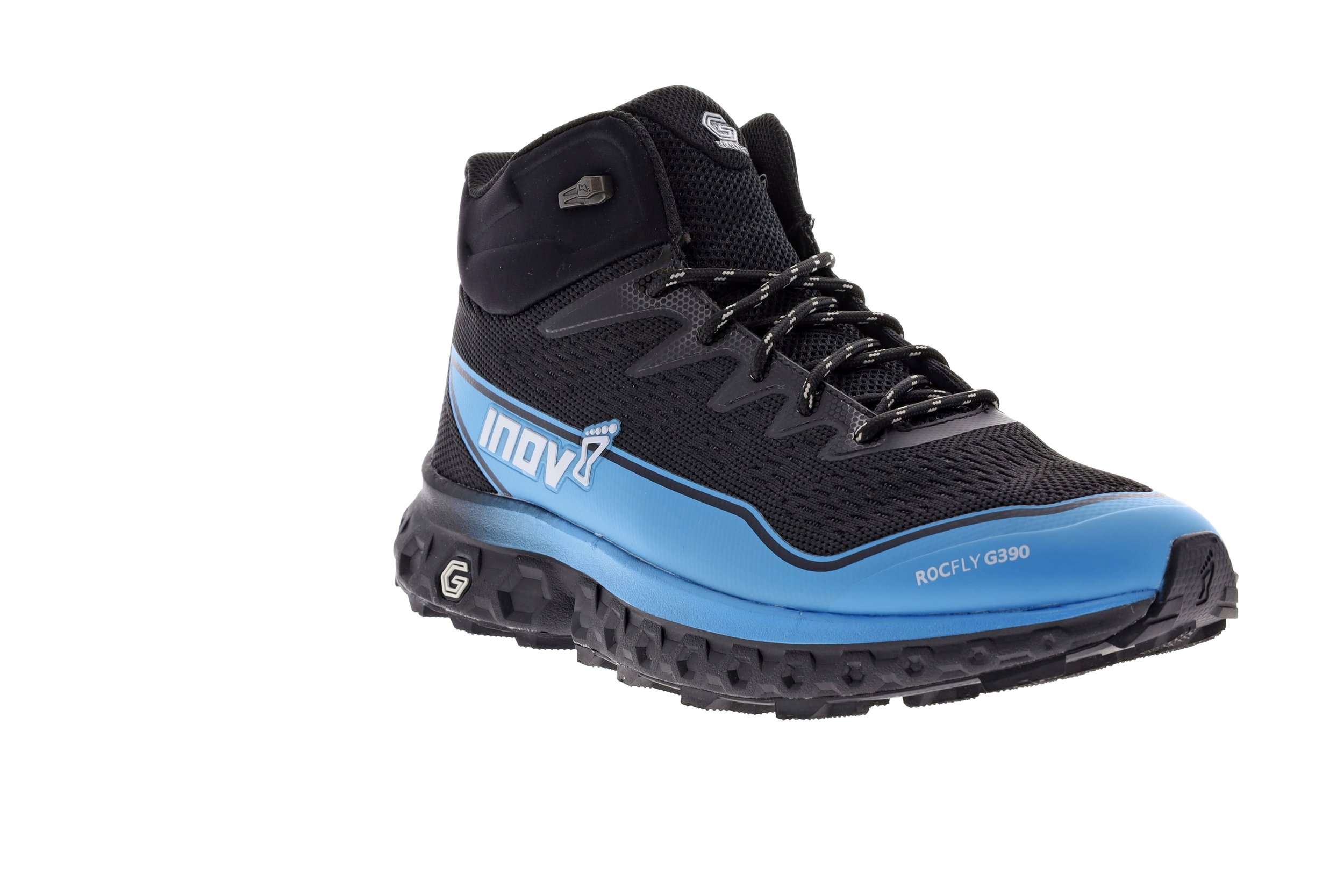With stride-boosting technology, the grippiest outsole on the market, and the power to keep going for years on end, is this a perfect boot for serious miles?
“On every surface from thick, squelchy farmyard mud to tussocky moorland; from Lake District mountainside to wet, slippery coastal rocks, the Rocflys have performed astonishingly well.”
Get the best price on the Rocfly G 390 from #walk1000miles gear partner Sportsshoes.com
Tested by: Nick Hallissey, Deputy Editor, Country Walking
RRP: £175
Men’s version: Yes
Women’s version: Yes
Our rating: ****
Cumbria-based inov-8 have been doing remarkable things with a ‘wonder-material’ called graphene for the past two years. But with this new boot, they’ve taken the material – and their smart usage of it – to a whole new level.
Graphene is the building-block component of graphite, and at 1 atom thick, it is, so we’re told, the thinnest material known to science. It’s also exceptionally strong – some 200 times stronger than steel, with the knock-on effect that it makes any material to which it’s added incredibly grippy and durable. Like, you know, the sole of a walking boot.
Graphene was first isolated from graphite by two scientists from the University of Manchester in 2010; the pair duly won the Nobel Prize for Physics. The University is now home to the National Graphene Institute, and in 2016 inov-8 began working with them to develop Graphene-Grip. Their first graphene-powered running shoes were unveiled in 2018; walking boots followed (such as the excellent Roclite G 370), and tests in Country Walking quickly confirmed that these were every bit as durable and grippy as inov-8 had promised.
So what’s new here?
Well, with the Rocfly G 390, they’ve found a new use for graphene. As well as forming part of the outsole, it’s now in the midsole, in the form of a specially developed foam called G-FLY. The benefits, say inov-8, are potentially as game-changing as the Graphene-Grip: G-FLY is scientifically proven to deliver 25% greater energy return and retain its optimum levels of underfoot rebound and cushioning for longer.
The upshot? More bounce, more flex, longer strides. You can walk further, in more comfort, for longer. And the durability of graphene in theory means those benefits won’t fade away anytime soon.
And just as with Graphene-Grip, after five weeks of vigorous testing, it’s hard for me to dispute the claims it makes.
On every surface from thick, squelchy farmyard mud to tussocky moorland; from Lake District mountainside to wet, slippery coastal rocks, the Rocflys have performed astonishingly well. They give comfort and confidence over tricky stuff, and simply plough on for miles over easier terrain like woodland, concrete and grass. They are exceptionally comfortable, and exceptionally fun.
And, as hinted at by the name, all this happens in a boot that weighs just 390g. (By comparison, the vast majority of walking boots weigh in somewhere between 460 and 700g.)
A Very Big Walk
James Forrest on the West Highland Way during his Three Peaks trek; note the footwear.
Yep, this is definitely a lightweight boot in both spirit and structure. Grasp one in both hands and you can squash it flat and twist it laterally like a carwashing sponge. There’s no thick, sturdy rand or toecap to protect you from bumps and scuffs, and the collar has very little stiffness to it. And for many walkers, that will set alarm bells off: if your first priorities are support and sturdiness, the Rocfly probably isn’t what you’re looking for.
That said, look at James Forrest. Already the record holder for fastest self-supported and continuous completion of the Wainwright fells, two months ago he set exactly the same record for the National Three Peaks – climbing Ben Nevis, Scafell Pike and Snowdon and walking the entire 500-mile distance between them in 16 days, 15 hours and 39 minutes.
And he did it in the Rocflys – mountains and all.
Before we go TOO crazy with enthusiasm, we have to point out that 1) James is a dedicated speed walker; he’s seldom likely to want to use a thicker, heavier boot anyway, and 2) He is an ambassador for inov-8. But does that in any way undermine the Rocfly’s credentials? Not in my eyes. Having worn them on a few mountains myself, I can vouch for the fact they are surprisingly sturdy, so if big, stiff, super-supportive boots aren’t your thing, you may well be seriously impressed by what the Rocfly offers.
Of bigger concern is that they aren’t waterproof.
Another challenge for James and his Rocfly boots.
I asked inov-8 why not; the answer is that it saves weight and allows the boot to offer the same flexibility and breathability that is treasured by runners. There are no plans to release a waterproof version yet – although, as inov-8 point out, they have plenty of waterproof options (including Gore-Tex) elsewhere in their range.
And apparently the lack of a membrane didn’t trouble Mr Forrest, even in some of the dreadful conditions he faced on his 16-day hike. Some people can just take soggy feet and run with it. Or walk quite fast, at any rate.
The Bottom Line
For me, the waterproofing issue is the only significant drawback. Perhaps a waterproof version will come along in time, without it drastically undoing the good work of the G-FLY foam. But at the moment, if the day ahead is clear and no rain is forecast, these are exceptionally hard to resist.
I also have to take my hat off to a British brand that is innovating so successfully in a field where you might think everything has been done before. With science, guts and good friendships, inov-8 are cheerfully proving that new is possible – and that the results can be gobsmacking.
* Get the best price on the Rocfly G 390 from #walk1000miles gear partner Sportsshoes.com
* Find out more at the inov-8 website






